Single Tquark Events at CDF - D0
Frank D.
(Tony) Smith, Jr. - Nov-Dec 2006 - Here
is a pdf version of this page.
Here is
Update1
CDF has recently released two different analyses of its search for
single Tquark events:
My explanation for the apparent discrepancy is based on a
model of the Tquark - Higgs - Vacuum system in which the T-quark is
regarded, not as a simple quark with mass about 175 GeV, but as a
system in which the Tquark has three mass states:
CDF and D0 observed 3 peaks in their T-quark data (see
FERMILAB-PUB-94/097-E from CDF and hep-ex/9703008 from D0):
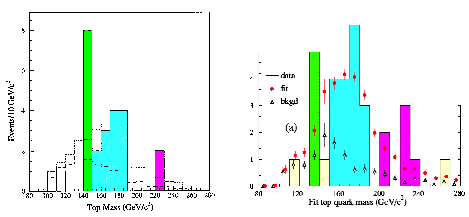
The middle (cyan) peak ( around 175 GeV ) is the one they
initially identified as the T-quark.
The low peak (green) around 130-150 Ge V and the high peak
(magenta) around 225 GeV can be understood in terms of Froggatt's
paper hep-ph/0307138 in terms of a 3-part system of the T-quark,
the Higgs, and the Triviality
Bound, with a high-energy cut-off that goes all the way to the
Planck energy 10^19 GeV (the graph below also shows curves for
cut-offs at 10^16 and 10^10 GeV and it can be seen that a
GUT-level cut-off around 10^16 GeV gives similar results).
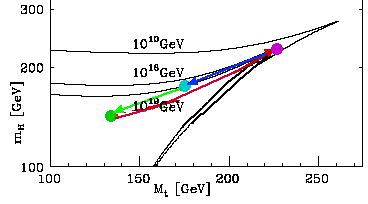
For one example of the high and low peaks, look at the D0 event
Run 84395, Event 15530 ( mu mu ) described in the 1997 UC Berkeley
PhD thesis of Erich Ward Varnes and in hep-ex/9808029
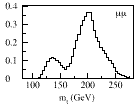
analyzed using the matrix-element weighting algorithm that,
according to hep-ex/9808029, "... is an extension of the weight
proposed in [R.H. Dalitz and G.R. Goldstein, Phys. Rev. D45,
1531 (1992)] ...". Further examples of events related to the
three peakcan be found at http://www.valdostamuseum.org/hamsmith/TQ3mHFII1vNFadd97.pdf
Further details can be found in:
- the paper by Koichi Yamawaki at hep-ph/9603293 describing
Tquark condensate Higgs models ( NJL and BHL ) that seem to be
related to the low and high T-quark peaks; and
- the paper by Michio Hashimoto, Masaharu Tanabashi, and
Koichi Yamawaki at hep-ph/0311165 describing a Tquark
condensate models in 8-dimensional spacetime ( with 4 compact
dimensions ) that seem to be related to the middle T-quark
peak.
In that 3-peak model:
- the peak around 175 GeV is on the curve of the Triviality
Bound and is therefore closely related to the Higgs and T-Tbar
condensates, and hence to T-Tbar events, while
- the peak around 130-150 GeV is in the stable region far from
the triviality and vacuum stability bounding curves and is
therefore closely related to other quarks in the stable region and
therefore to single-Tquark events involving such things as T-Bbar
events,
so it is natural that
the LF method which only looks at events near Tquark mass 175 GeV
would miss single-Tquark events, while
the ME method would see single-Tquark events, which would be seen
at Tquark mass below 150 GeV.
Likelihood Function (LF)
Method
Tommaso Dorigo in his Nobember 2006 blog entry at
http://dorigo.wordpress.com/2006/11/07/the-elusive-single-top/ said,
about search for single-Tquark events at CDF by the Likelihood
Function (LF) method:
"... CDF has recently blessed two new results on the
search for the process called "single top production" ... All
searches for the elusive single top quark production have been
[u]nsuccessful so far. ... We thought that one inverse
femtobarn of available CDF data would do the trick. ... Not yet.
In a careful analysis of "W+2jet events" ... ones containing a
lepton, missing energy originated by a neutrino, and two jets, at
least one of which originated from
b-quark hadronization, CDF can not measure the
production of single top yet, and actually is in the awkward
position of excluding its production according to the predictions
of the Standard Model. ...
Nobody really believes that single top production is not there:
it must be. It probably is just a unlucky downward fluctuation of
our data. But still, it starts to be embarassing! Here you
can see a plot of the event likelihood, constructed with all
available kinematic information, for the set of events where the
search has been conducted.
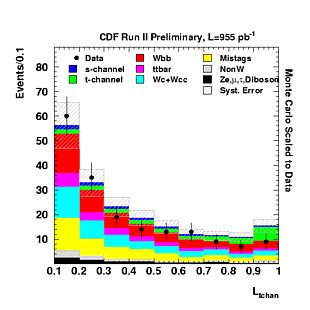
... the single top production processes (actually mostly the
t-channel one in this particular plot ...) should contribute
sizeably (green and blue histograms), but they do not, and in fact
we observe a deficit of events with respect to all concurrent
background processes.
... the most probable value of the cross section for single top
production via "s-channel" and "t-channel" processes (two
different mechanisms that should both yield a single top signal,
which have been searched independently in the data) is very close
to zero,
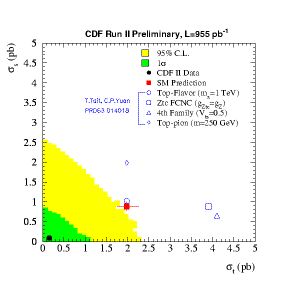
and that the standard model prediction (the red point on
the right) is actually excluded! ...".
Matrix-Element (ME)
Method
In a comment to the Tommaso Dorigo blog entry mentioned above,
Andrea Giammanco said:
"... Thanks to the CDF analysis webpages (discussed in
this site a few days ago) I see that there is an inconsistency
between this result and one, yet to be pubished, with a competing
method:
http://www-cdf.fnal.gov/physics/new/top/2006/SingleTop/ME_1FB/index.html
http://www-cdf.fnal.gov/physics/new/top/2006/SingleTop/COMP_MELF_1FB/compat.html
That's thrilling! ...".
The description of the "competing method" of Matrix-Element (ME)
analysis in the paper "Search for Electroweak Single Top Quark
Production using the Matrix Element Method with L=955 pb-1" by
Florencia Canelli (FNAL), Peter Dong (UCLA), Bernd Stelzer (UCLA),
and Rainer Wallny (UCLA) that is at at
http://www-cdf.fnal.gov/physics/new/top/2006/SingleTop/ME_1FB/index.html
said:
"... We performed the first search for single top using a
Matrix-Element based analysis. We apply our method to 955 pb-1 of
data taken by the CDF experiment. We include rate and shape
systematic uncertainties in our method. We measure a single top
cross-section &sigmasingle top =2.7+1.5-1.3pb. ...
More cross-checks ... We look at variables which are sensitive
to single top production. As we make increasing cuts on our event
probability discriminant (EPD), we can observe the increasing
sensitivity of these variables and the behavior of the data.
...
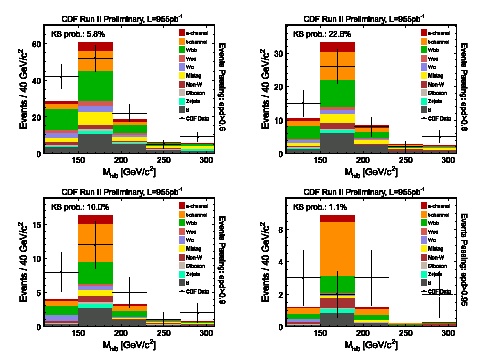
Increasing cuts on the EPD for the invariant mass of the
lepton, neutrino, and b-jet.
...
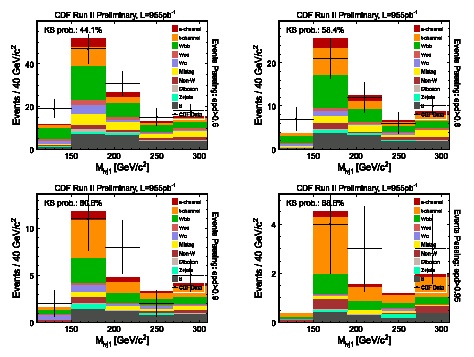
Increasing cuts on the EPD for the invariant mass of the
lepton, neutrino, and leading jet.
...
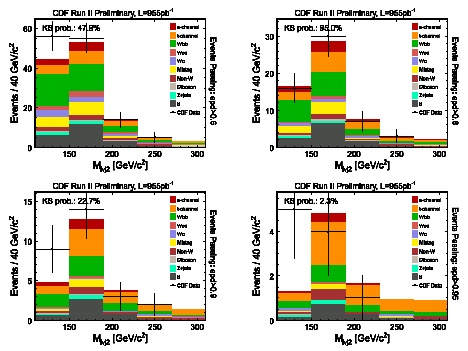
Increasing cuts on the EPD for the invariant mass of the
lepton, neutrino, and second jet. ...".
It seems to me that the invariant mass cross-check data shown
above indicate that much of the excess of events over background is
in the bin for 0 to 150 GeV.
The main deviations that I see from that seem to be in the
third and fourth histograms for "leading jets" (in which many excess
events seem to be in the 200 to 250 GeV bin) and in the second
histogram for "second jet" in which there is not much excess at all,
just a little in the 150 to 200 GeV bin.
So, overall, it seems to me that the ME method does in fact see
single-Tquark events, but that they are mostly seen in events with
Tquark mass below 150 GeV.
Discussion
Tommaso Dorigo, in a 19 November 2006 e-mail message to me,
said:
"Hi Tony,
indeed, part of the excess in the matrix element analysis is at
low invariant mass... Some of the KS probabilities are smallish,
although of course many variables are tested and if one plays the
game of going for the fluke in one out of many distributions one
is sure to find it.
In your case though, you have a reason for looking specifically
for those one or two distributions (low three-object masses) and I
agree that you score a point there.
As for the other analysis, the likelihood of course selects
"top-like" stuff, intended at 172 GeV of mass or so, and so a top
quark with low mass would not contribute to the signal region too
much.
Therefore yes, I agree that as far as present data is
concerned, a single top quark of mass below 150 GeV could still be
present in our data without us realizing it with the used
means.
I think one more year -two times the data we have analyzed so
far- will give you a more clear answer. If you have theoretical
input to submit to our experimenters working at new physics
searches, I suggest you talk to our exotics physics conveners
(their e-mail is in the web page of exotics analyses).
Cheers,
T. ".
I expect to send an e-mail message to the exotics physics
conveners as suggested by Tommaso Dorigo.
Tommaso Dorigo has put up an entry about this on his blog
at
...







